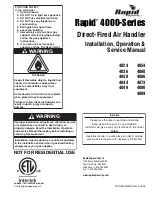
44
5.0 COMPONENTS & C0NTROLS
5.1 BLOWER MOTOR
All (-)H1P models have 2-speed single-phase permanent split capacitor (PSC) style motors.
• The 208/240 volt models also have voltage taps that allow the motor to be configured
to restore full air-flow performance in 208 volt applications.
• The low speed tap is for applications with duct system external static pressures up to
0.5” W.C. and the high speed tap is for applications with external static pressures
from 0.5 – 0.7” W.C.
• A run capacitor is required for the PSC motors which is mounted on the blower hous-
ing. Speed and voltage change instructions are detailed in Sections 3.13.1 & 3.14.2
of this manual.
All (-)H1T models have 5-speed constant torque electronically commutated (ECM) style
motors that are significantly more efficient than PSC motors.
• The 208/240 volt models
do not
require the motor to be reconfigured for 208 volt
applications, although the control transformer must still be reconfigured for 208 volt
applications.
• The motor has a control module mounted on the end of the motor opposite the shaft
end which is replaceable should only the control module itself fail.
• Constant torque ECM motors do not require a run capacitor.
• A terminal block on the motor shell is provided for the 5 speed taps, labeled T1 – T5.
The speed taps are 24VAC inputs.
Do not connect line voltage to these speed
taps.
T1 provides the slowest speed and is dedicated to continuous fan operation.
T2 – T5 are for cooling & heating operation and are selectable at the terminal block
using a single wire with an insulated terminal that plugs onto the terminals in the ter-
minal block. Speed change instructions are detailed in Section 3.14.2.
• The constant torque motor has a built in soft start that will ramp the motor up to speed
gradually.
• An off-delay is built into the control of the motor that keeps the motor energized for 30
seconds after 24 volts is removed from all speed tap terminals.
• If two of the speed tap terminals (T1 – T5) are energized with 24 volts simultaneously,
the motor will operate at the higher of the 2 speeds. An example of this is when the G
and Y thermostat inputs are both energized in the cooling or heat pump heating
mode. In this case, T1 (continuous fan) and a higher numbered speed tap will both
be energized resulting in the motor operating at the higher speed to support the cool-
ing or heat pump heating air-flow requirement.
• The air-flow delivery rate for a constant torque ECM motor will not decrease as much
as it does with a PSC motor as external static pressure increases.
5.2 MOTOR RUN CAPACITOR
Only the (-)H1P models have a run capacitors due to the fact they have PSC motors.
The capacitor is mounted on the blower housing using a sheet metal strap. The micro-
farad (mfd) & voltage ratings vary depending on the blower motor and must be replaced
with one with the same rating, except 370V rated capacitors can always be replaced
with a 440V rated capacitor.
5.3 BLOWER CONTROL
An electronic blower control is provided to control blower motor & electric heat operation
and is located inside the control box attached to the blower housing. The blower control
in the (-)H1P and (-)H1T operate differently as described below.
(-)H1P Blower Control
• The contacts in the on-board relay (BR) are used to connect line voltage to the motor
speed tap when there is a call for motor operation. Motor speed changes are made
by switching motor speed taps at this relay.
• The control has an on-board 3 amp automotive style fuse to protect the control circuit.
• A plug on the electric heater kit wiring harness plugs into a 4 pin plug receptacle on
the blower control to allow control of the electric heater by the blower control based
on thermostat input.
• There is a 5-pin connector for the thermostat pigtail harness to connect to. Wires
from the thermostat do not connect directly to the blower control, but rather to the pig-
tails that are routed to the exterior of the air-handler cabinet.
• There is a 2 second on-delay for blower operation when there is a call for blower
operation.
• There is a 30 second blower off-delay when a call for cooling or heat pump heating
ends.
• There is a 75 second blower off-delay when a call for electric heating ends. This
allows time for the contacts in the bi-metallic disc type heating sequencer to open
which de-energizes the heater elements.






























